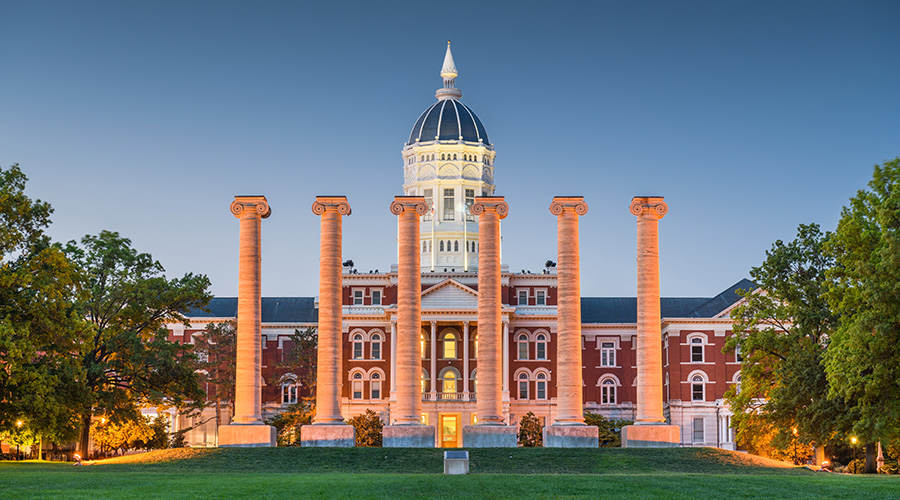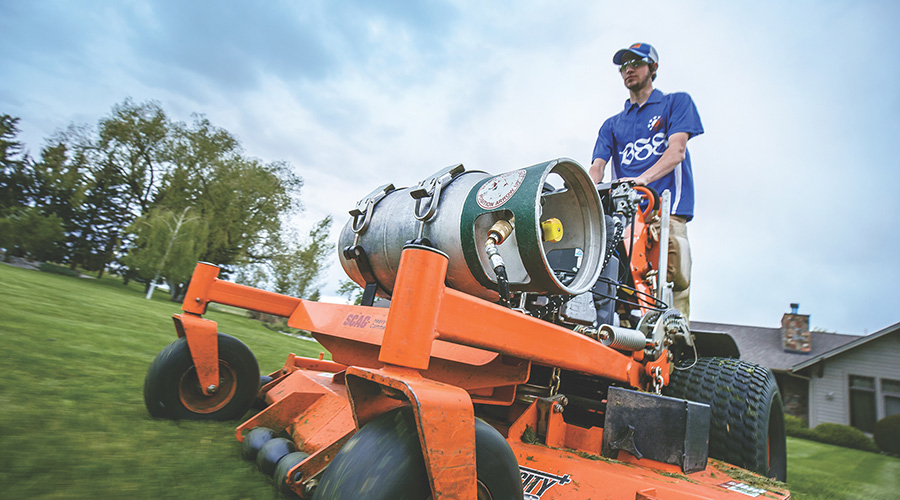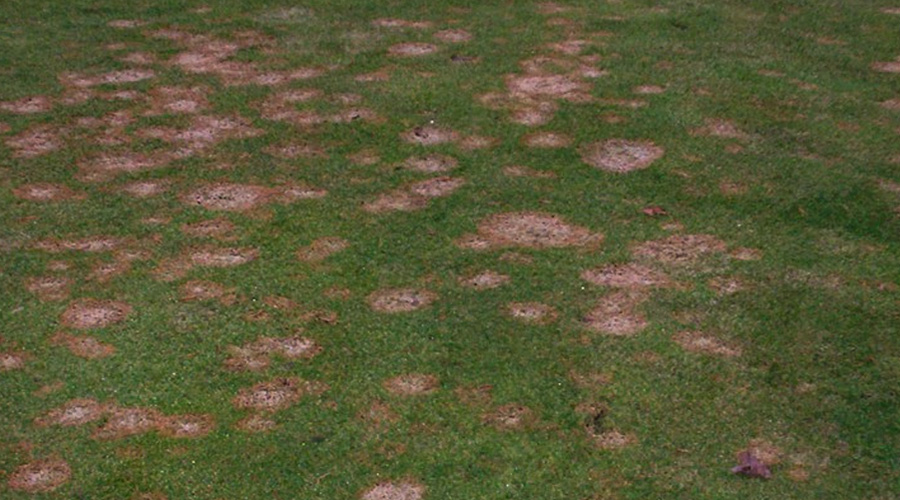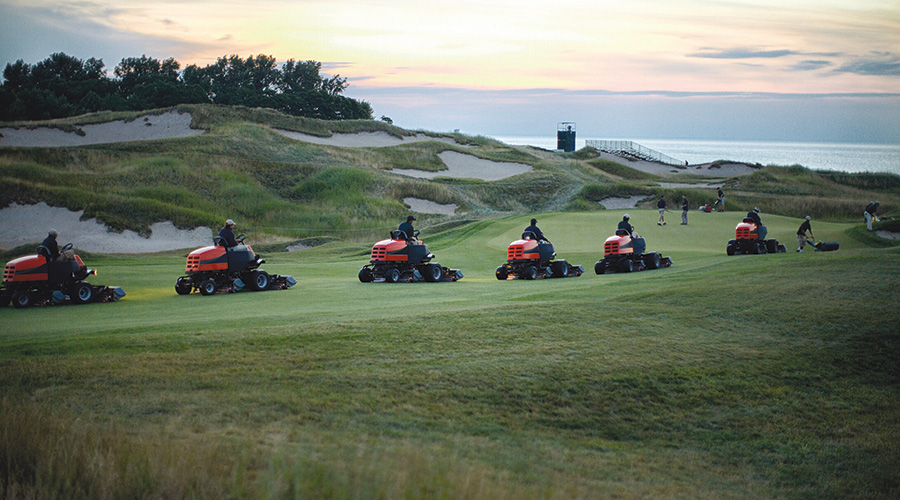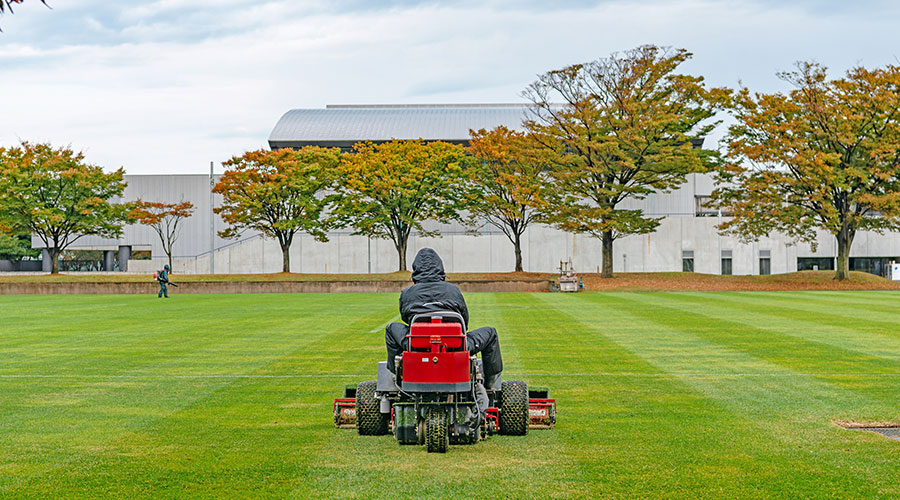University Maximizes Utilities Projects to Benefit Grounds
Effective planning enables University of Missouri’s landscape services to deliver successful projects that withstand a campus tradition.
By Dan Hounsell, Senior Editor
The challenge facing Blair Crosby in May 2024 was anything but an ordinary grounds management issue. It went beyond staffing or meetings or budgets. It involved the potential threat posed to the turf on the University of Missouri campus by the pounding feet of thousands of college students.
“A tradition here at the University of Missouri is that incoming freshman run into the university through the through the columns on the quad, and then exiting students run out,” says Crosby, the university’s operations manager for landscape services, referring to the Francis Quadrangle.
The potential problem was that the event — the annual Tiger Walk — was set to take place on an area of campus that had been slated for utilities updates, followed by the placement of new sod. Delivering successful projects would mean completing all these tasks before students stormed the grounds.
Campus considerations
The University of Missouri campus hosts 31,500 students and features 200-plus buildings on its 1,300-acre main campus in Columbia. Not included in those 200 buildings are six Ionic limestone columns on Francis Quad standing 43 feet tall.
“They're from an original building that burned down on campus in the 1890s,” Crosby says. “Those columns were left ever since. The students had a big push to keep them after it burned down, so that's one of the iconic pictures on the University of Missouri is those columns that are still standing.”
The columns are a high-profile feature of the campus, which is designated as a botanic garden.
“We mainly focus on probably 150-200 acres as truly the botanic garden — the main part of the mowed campus and the classroom buildings,” he says. “We obviously can't maintain that much, so we've pared it down to some specialty gardens around the Francis Quad, Carnahan Quad and a few other places that are bigger draws for people who want to come see that part of the botanic garden.”
The largest construction project, which began immediately after graduation in May 2024, replaced a brick tunnel from the 1880s on the Francis Quad that had delivered utilities to a large part of campus with a larger concrete structure that allows for increased capacity and future growth.
“Another steam tunnel by Switzler Hall needed to be redone because of a possible future building site just off the Francis Quad, so they updated that steam tunnel,” Crosby says.
Because of the project’s location under Francis Quad, Crosby saw an opportunity to address an ongoing grounds issue.
“There was a large storm sewer that came through there, and it just wasn't quite right,” he says. “There were lots of low spots and places that were holding water. Eight or nine years ago, they added a few more inlets to help with drainage for the steam tunnels. They were getting some water infiltration.
“Once they started talking about the impact to the quad itself from the big steam tunnel portion of it, I was pushing to get us to regrade at least the south half (of the quad). That would allow us to get rid of some of those low spots to help drainage throughout the quad.”
The projects also allowed Crosby to improve the aesthetics of a high-profile area of campus.
“Lots of people — our directors, our chancellor, the president of the university — look out on that quad every day,” he says. “The students use it a lot. So we were trying to update things and get a grasp so that we could help maintain the area a little better and get them up to date.
“The turf was pretty well worn out,” he says. “We hadn't resodded the whole thing in the 12 or 13 years that I've been here, and I don't think it had been done ever, possibly. There was a chance to just revitalize it.”
Crosby says it took a close review of campus photos for him to realize the turf was not in the condition it appeared to be.
“I'd always thought it looked green until I compared old pictures to new pictures and noticed how many weeds were out there that were actually the green part of it, not the turf,” he says. “It was a striking moment for me. I thought it was green, but I didn't realize it was lots of weeds that were green and not grass.”
The projects also gave the department the opportunity to address one other landscape issue beyond drainage and aesthetics.
“We took the opportunity to put in a whole new irrigation system,” he says. “We stripped all the turf off, did some cultural practices to get it loosened up a little bit and then laid new sod on 4 1/2 acres.”
Part of successful planning for the utilities upgrades for Crosby involved having a say on essential products and technology that would be installed.
“I don't get involved in the mechanical side other than trying to say where I don't want a manhole or something like that if we can avoid it,” he says. “We hired an architect to help us on this one.
“As far as irrigation, drainage, all those things, landscape services got to say in what we wanted done. For the irrigation system, they drew it up for us. We looked at it. We approved it. The system is working well for us. It gives us more room to expand, which we're already planning on doing. It gave us some flexibility in performance.”
Solving challenges, ensuring performance
While upgrades of facilities and landscapes are always complex, projects involving components that have been in use for decades and even centuries can be especially problematic.
“The land has been in the university’s control since the 1800s, so there's lots of utilities out there — known, unknown and who knows what they were. There are lots of old building materials out there from when the academic hall burned, so there were bricks and different things. I don't think we got into any foundation this time, but there is still foundation out there, and every once in a while, depending on what we're trying to do, it rears its head and causes an issue.”
Locating the components of outdated campus utilities systems presented especially challenging issues.
”We thought we knew where they were, and they weren't quite there,” Crosby says. “The biggest thing was the unknown utilities. We had our energy management department to figure out what they were. They have maps of a lot of it — not 100 percent, obviously. Once something was deemed to be an abandoned utility, we could move ahead.”
Crosby’s challenges in helping deliver successful projects also required coordinating the flow of workers, equipment and materials needed to complete the work on schedule.
“The northern part of the Francis Quad became a large laydown yard for several months,” he says. “It wasn't landscape services’ intention to have that happen. But to get all the projects done in a timely manner, we had to play that game where everybody got to use it for a while.
“We ran into complications toward the end because they were trying to wrap up their project, and we were trying to start grading and doing things on the north side of that sidewalk to get ready for sod. By the end, we were cramming everybody down to a smaller and smaller area.”
Despite the many challenges and moving pieces involved in completing the projects on a tight schedule, Crosby and his department were able to provide a suitable surface on Francis Quad for the university’s longstanding tradition.
“The campus had a large expectation that in August, we were going to run 3,000 students across it, so it obviously took a little bit of a turn downhill just because of us trying to balance water for new sod versus trying to get it dry enough for students to run across,” he says. “We had turf down for a few days before 2,000-3000 students ran across it so they could run into the university. That was one of our big hurdles — to have sod down so they could run.
“We had a small portion — probably 10,000 square feet, 15,000 square feet — that didn't have sod on it for Tiger Walk. We put up temporary fencing to keep people out of the mud. We were able to cut off the new irrigation system in such a way that we could water the new sod but not make it a mud pit for the other guys working. After Tiger Walk, it was probably another week and a half until we got everything sodded.”
Dan Hounsell is senior editor for the facilities market. He has more than 30 years of experience writing about facilities maintenance, engineering and management.
Related Topics:








